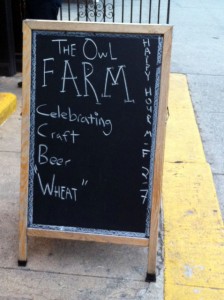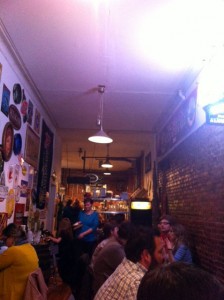A couple weeks ago, I was able to partake in portions of the 5th annual New York City Beer Week, a celebration including over 100 venues, 300 events, and the takeover of hundreds of tap lines. Some of the city’s most acclaimed restaurants, bars, and chefs helped showcase the importance of craft beer on a massive scale.
I made my way into Brooklyn to check out a few events and brews. Although there were plenty of imports on the participant’s beer lists, there was a noticeable emphasis on what’s being brewed locally. Establishments that embrace a “locavore” approach to their beverage program are a major stand out, in my eyes. Every place I visited had at least one draft line dedicated to something brewed on Long Island. That being said, you have to do some sifting to find what vendors are putting together original, entertaining events, rather than just trying to drag you in for dinner. I found some that delivered.
 The Owl Farm in Park Slope, Brooklyn, dubbed their version of the week-long brew fest, “NYC Beer Wheat.” Their aptly named take on the promotion featured more than a dozen wheat beers ranging from funky to fresh. The “Battle of the Weizenbocks” pitted two high-scoring, hyped up wheat beers in a cage match that left everyone cheery and bruise-less; I didn’t even break a sweat. Weizenbocks are brewed with over 50% wheat and fermented to Dopplebock strength, usually over 6.5% ABV. The G. Schneider and Sohn “Aventinus” (Germany), and High Point Brewing Co’s. “Ramstein Winter Wheat” (New Jersey) are two powerhouses in the category.
The Owl Farm in Park Slope, Brooklyn, dubbed their version of the week-long brew fest, “NYC Beer Wheat.” Their aptly named take on the promotion featured more than a dozen wheat beers ranging from funky to fresh. The “Battle of the Weizenbocks” pitted two high-scoring, hyped up wheat beers in a cage match that left everyone cheery and bruise-less; I didn’t even break a sweat. Weizenbocks are brewed with over 50% wheat and fermented to Dopplebock strength, usually over 6.5% ABV. The G. Schneider and Sohn “Aventinus” (Germany), and High Point Brewing Co’s. “Ramstein Winter Wheat” (New Jersey) are two powerhouses in the category.
Out of New Jersey, the dark and feisty Ramstein put up a fight against the well-established Aventinus, which has been brewed in Bavaria since 1907. It’s no wonder that High Point Brewing Co. imports every ingredient from Bavaria, including a special brewer’s yeast to make “Ramstein.” Ultimately, the “Aventinus” edged out the relative newcomer. If there was ever an argument that beer can show typicity, this yeasty matchup settled it.

The local scene is represented well by Bierkraft, a Brooklyn beer shop with a great bottle/growler selection and even better Italian heros. Bierkraft hosted a barleywine vertical tasting with Greenport Harbor Brewing Company the night I stopped by.
Brewers DJ Swanson, and Greg Doroski, brought three vintages of their “Triton” for us to taste. Triton is an approachable take on the Barleywine style. Both the oldest (2011) and most recent (2013) have a complex fruitiness that leaves out some of the overt sourness which can overpower a barleywine. The night provided to be an interesting lesson on the effects of aging a beer that was made to mature.
The Gate, a craft-friendly bar, was also playing host to a vintage-based event during Beer Week. They had kegs of three rare beers that are virtually impossible to find. Offered that night were different sized samples and pints of the Goose Island 2007 “Pere Jacques”, Two Brothers 2011 “Hop Juice Imperial IPA”, and The Hair of the Dog 2011 “Adam.” To some, it may just seem like sitting around drinking old beer, but to beer geeks, it’s like finding an old vinyl at a yard sale.
Although many of the beers I tried were not brewed in NY, the fact that such a great craft-beer scene is growing even larger is exciting to witness.
Dousing the market in a blitzkrieg of beer related events makes a larger impact than any single brewery could accomplish on its own. The hopes for the organizers and breweries are that their kegs stay at these bars long after beer week has ended. The exposure of these artisans will increase the demand for them, and help them grow. The selection and quality of what’s being served will only elevate if we, the customer, dictate it. So next time your favorite local bar isn’t pouring a local draft, ask “Why not?”.
Unified marketing campaigns like New York City Beer Week can be very effective in creating a buzz around craft beer or any other beverage. Great marketing and increased participation make it difficult for people not to know about it. The Beer Week website could definitely use some work. The events were not listed clearly enough, and they could’ve used some direct links to the host’s sites explaining their part in the promotion.

